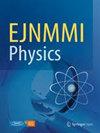Biodistribution and radiation dosimetry of 124I-mIBG in adult patients with neural crest tumours and extrapolation to paediatric models
IF 3
2区 医学
Q2 RADIOLOGY, NUCLEAR MEDICINE & MEDICAL IMAGING
引用次数: 0
Abstract
Positron emission tomography (PET) using 124I-mIBG has been established for imaging and pretherapeutic dosimetry. Here, we report the first systematic analysis of the biodistribution and radiation dosimetry of 124I-mIBG in patients with neural crest tumours and project the results to paediatric patient models. Adult patients with neural crest tumours who underwent sequential 124I-mIBG PET were included in this retrospective single-center analysis. PET data were acquired 4, 24, 48, and/or 120 h after administration of a mean of 43 MBq 124I-mIBG. Whole-body counting and blood sampling were performed at 2, 4, 24, 48 and 120 h after administration. Absorbed organ dose and effective dose coefficients were estimated in OLINDA/EXM 2.2 according to the MIRD formalism. Extrapolation to paediatric models was performed based on mass-fraction scaling of the organ-specific residence times. Biodistribution data for adults were also projected to 123I-mIBG and 131I-mIBG. Twenty-one patients (11 females, 10 males) were evaluated. For adults, the organs exposed to the highest dose per unit administered activity were urinary bladder (1.54 ± 0.40 mGy/MBq), salivary glands (0.77 ± 0.28 mGy/MBq) and liver (0.65 ± 0.22 mGy/MBq). Mean effective dose coefficient for adults was 0.25 ± 0.04 mSv/MBq (male: 0.24 ± 0.03 mSv/MBq, female: 0.26 ± 0.06 mSv/MBq), and increased gradually to 0.29, 0.44, 0.69, 1.21, and 2.94 mSv/MBq for the 15-, 10-, 5-, 1-years-old, and newborn paediatric reference patients. Projected mean effective dose coefficients for 123I-mIBG and 131I-mIBG for adults were 0.014 ± 0.002 mSv/MBq and 0.18 ± 0.04 mSv/MBq, respectively. PET-based derived radiation dosimetry data for 124I-mIBG from this study agreed well with historical projected data from ICRP 53. The effective dose coefficients presented here may aid in guidance for establishing weight-based activity administration protocols.124I-mIBG 在神经嵴肿瘤成人患者中的生物分布和辐射剂量测定,以及对儿科模型的推断
使用 124I-mIBG 的正电子发射断层扫描(PET)已被用于成像和治疗前剂量测定。在此,我们首次系统分析了124I-mIBG在神经嵴肿瘤患者中的生物分布和辐射剂量测定,并将结果投射到儿科患者模型中。这项回顾性单中心分析纳入了接受124I-mIBG PET连续检查的成人神经嵴肿瘤患者。正电子发射计算机断层显像数据是在平均施用 43 MBq 124I-mIBG 后 4、24、48 和/或 120 小时采集的。在用药后 2、4、24、48 和 120 小时进行了全身计数和血液采样。器官吸收剂量和有效剂量系数在 OLINDA/EXM 2.2 中根据 MIRD 公式进行估算。根据器官特异性停留时间的质量-分数比例,对儿科模型进行了外推。成人的生物分布数据也被预测为 123I-mIBG 和 131I-mIBG。对 21 名患者(11 名女性,10 名男性)进行了评估。就成人而言,单位施用活度剂量最高的器官是膀胱(1.54 ± 0.40 mGy/MBq)、唾液腺(0.77 ± 0.28 mGy/MBq)和肝脏(0.65 ± 0.22 mGy/MBq)。成人的平均有效剂量系数为 0.25 ± 0.04 mSv/MBq(男性:0.24 ± 0.03 mSv/MBq,女性:0.26 ± 0.06 mSv/MBq),而 15 岁、10 岁、5 岁、1 岁和新生儿参照患者的平均有效剂量系数则逐渐增加到 0.29、0.44、0.69、1.21 和 2.94 mSv/MBq。成人 123I-mIBG 和 131I-mIBG 的预测平均有效剂量系数分别为 0.014 ± 0.002 mSv/MBq 和 0.18 ± 0.04 mSv/MBq。该研究基于 PET 得出的 124I-mIBG 辐射剂量数据与 ICRP 53 的历史预测数据非常吻合。这里提出的有效剂量系数可能有助于指导制定基于体重的活动给药方案。
本文章由计算机程序翻译,如有差异,请以英文原文为准。
求助全文
约1分钟内获得全文
求助全文
来源期刊

EJNMMI Physics
Physics and Astronomy-Radiation
CiteScore
6.70
自引率
10.00%
发文量
78
审稿时长
13 weeks
期刊介绍:
EJNMMI Physics is an international platform for scientists, users and adopters of nuclear medicine with a particular interest in physics matters. As a companion journal to the European Journal of Nuclear Medicine and Molecular Imaging, this journal has a multi-disciplinary approach and welcomes original materials and studies with a focus on applied physics and mathematics as well as imaging systems engineering and prototyping in nuclear medicine. This includes physics-driven approaches or algorithms supported by physics that foster early clinical adoption of nuclear medicine imaging and therapy.
 求助内容:
求助内容: 应助结果提醒方式:
应助结果提醒方式:


